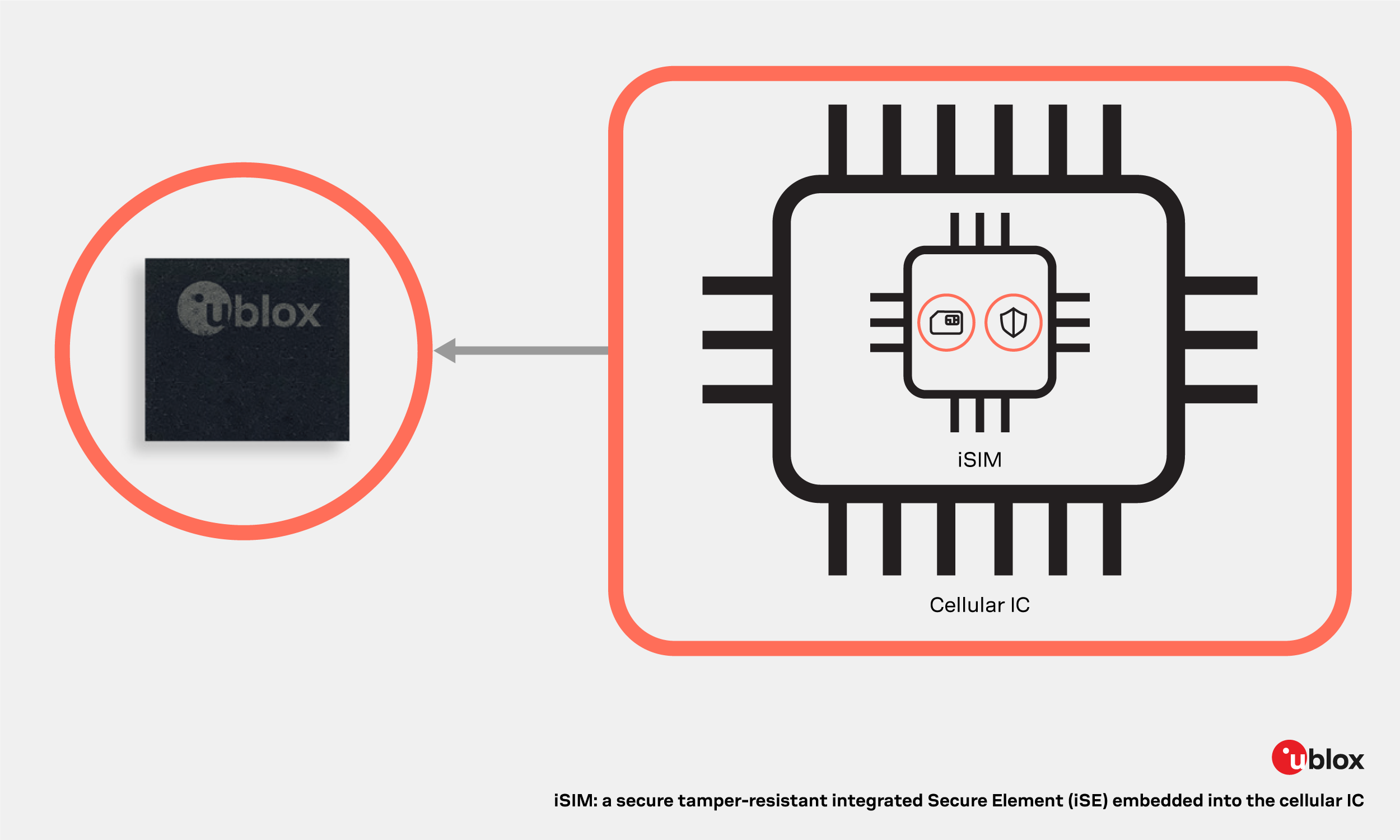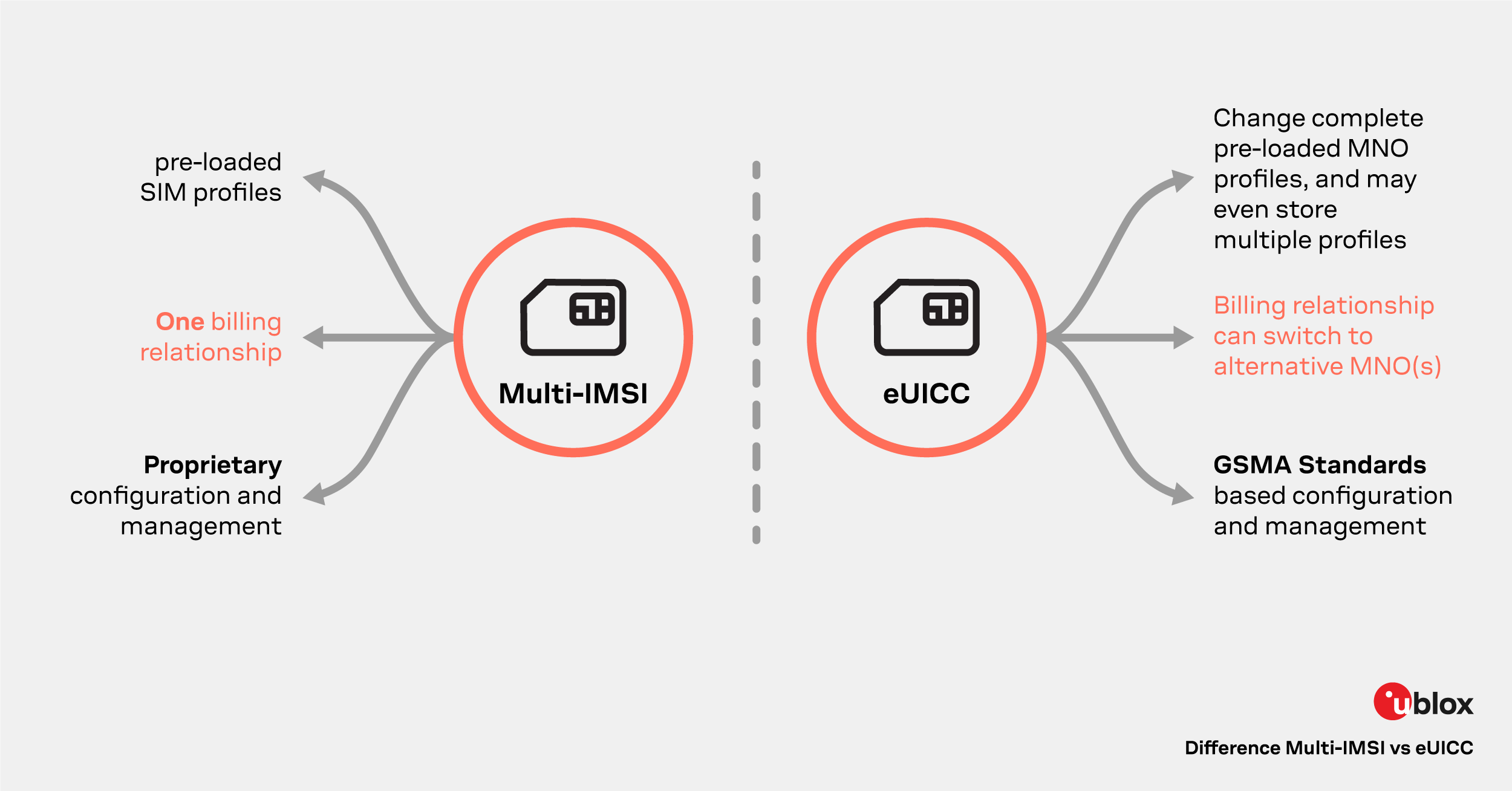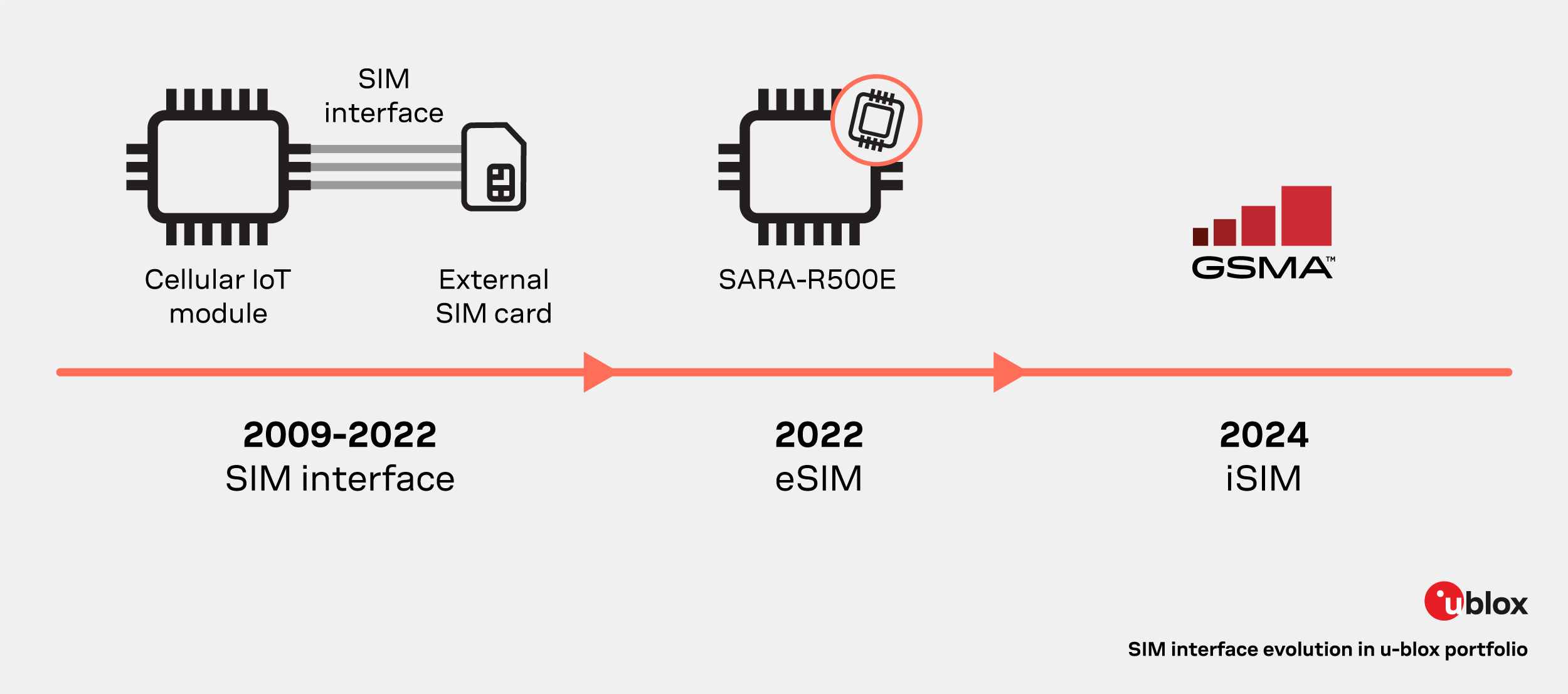
- Support portal
- Evaluation Kits and partner products
u-blox Support
- Product documentation
Documentation
- Investor relations
Investor relations
Technology
|
15 Jun 2023
You may have heard that iSIMs are on the rise. But how do they differ from eSIMs, soft SIMs, and physical SIM cards?
You may have heard that iSIMs are on the rise. But how do they differ from eSIMs, soft SIMs, and physical SIM cards? What are their unique benefits? How will they impact IoT devices going forward? Read on to learn why SIM technology matters, where it came from, where it's headed, and why the iSIM is such a big deal for the Internet of Things.
From day one, SIM technology has been an essential enabler of the Internet of Things (IoT), a connected ecosystem in which devices and systems store, process, and exchange data to accomplish tasks. The IoT ecosystem comprises many entities, but to put it simply, they make up four categories:

In this ultra-simplified view, IoT devices are made up of two components: an IoT cellular module, in charge of establishing connectivity, and a SIM, that enables network access. Depending on their application, IoT devices can, of course, be more complex and include additional technologies and sensors.
SIM stands for subscriber identity module. We’re all familiar with the technology from the SIM cards we insert into our mobile phones. A SIM is an integrated circuit (IC) that securely identifies users, contains encryption algorithms, and crucially, grants users access to cellular communication networks. As we all know: no SIM means no network access (except for emergency calls).
A closer look reveals that a SIM contains several identifiers:
The first SIMs were about the size of a credit card. While SIMs became smaller and smaller with each successive generation – in their Mini SIM, Micro SIM, and Nano SIM form factors – they were all physical cards that granted devices access to the mobile network.

In the early 2010s, a new option appeared in the market: the eSIM. The embedded SIM (eSIM) typically produced in the MFF2 form factor was initially offered as a rugged and more secure alternative to the plastic SIM card. An eSIM is simply a SIM chip containing an MNO profile, soldered onto the PCB.

eSIMs have a many benefits compared to standard plastic SIM cards, including that they are:
The eSIM was quickly adopted by the automotive market, as well as for rugged applications where robustness and reliability are vital, for example, metering and industrial monitoring.
The term eSIM is often wrongly used to refer to an embedded SIM with eUICC functionality, creating false expectations. To be clear: eSIMs do not necessarily offer eUICC functionality, which means that they can be provided with a fixed MNO profile without offering the flexibility to change the MNO profile later on.
An eSIM is essentially just a hardware component. Enabling MNO profile updates over-the-air requires two additional elements: eUICC capability and the availability of a remote SIM provisioning (RSP)/SIM management system to remotely control the SIM provisioning process. The first, eUICC capability, is enabled using an embedded universal integrated circuit card (eUICC), a software component of a SIM that allows for over-the-air secure RSP.
The availability of eUICC capability triggered a surge of different RSP systems, some custom implementations and others supporting GSMA standards. Together, they drove eSIM adoption, first in automotive and later in consumer markets.
The appearance of the eSIM standard with all its benefits, including reduced cost, led to attempts to de-materialize the SIM by integrating it in the cellular module’s software. Different developers introduced proprietary names for their solutions based on this “soft SIM” approach. However, lacking the security and integrity of hardware-based solutions, their software-based alternatives eventually failed. Even IoT modules with a “trusted zone” inside their cellular IC were not sufficiently secure and tamper-resistant to store a SIM OS or an MNO profile. In the end, most MNOs refused to support this approach. The few implementations that made it to the market are custom SIMs created in partnership with a specific MNO.
The latest iteration of SIM technology, the iSIM, brought about the true de-materialization of the SIM. The iSIM is basically an integrated SIM card contained inside the cellular IC, nested within it, but securely partitioned from it . It’s a system-on-chip (SoC) solution that stores the SIM in a secure, tamper-resistant element.

The difference between the iSIM and Soft SIM alternatives lies in where they store the SIM OS, the identifiers, and all the encryption algorithms. Unlike the software-based Soft SIM, the iSIM is a silicon-integrated secure element (iSE) embedded within but separate from the cellular IC. It contains the SIM OS and MNO profile and works just like a SIM card, offering the same security and tampering resistance as a classic SIM or eSIM.
iSIMs bring several benefits that simplify the production, deployment, and repurposing of IoT devices. For one, the fact that they come pre-integrated inside the cellular IC means that you don’t need to purchase and connect a physical SIM. All you need to do is profile it with the MNO of your choice using an RSP service.
By doing away with the physical SIM card holder, product developers benefit from reduced BOM cost and smaller end devices. Moreover, moving away from physical SIMs increases their device’s tolerance to vibrations and temperature cycles.
Other benefits concern logistics, purchasing, and lifecycle management: iSIMs make upfront negotiating and purchasing SIMs unnecessary. Without the SIM, there is less stock to manage in the warehouse. And not having to insert or solder SIMs during production reduces manufacturing costs.
Finally, using iSIMs, IoT devices can be stocked without the need to split up devices with different onboard SIM cards into different stock-keeping units (SKUs). Because the iSIM can be profiled post-production, all devices can be assigned to the same SKU.
In short, the iSIM is a SIM OS running on a Secure Element embedded inside the cellular IC, whereas the eSIM is a Secure Element running the SIM OS soldered onto a PCB.
The advantages of the iSIM vs eSIM are less obvious. The eSIM is a hardware component that needs to be purchased, profiled (if eUICC capability and RSP are unavailable), and soldered onto the board. This creates a cost factor impacting hardware manufacturing, procurement, and logistics. Moreover, purchasing eSIMs is not as easy as purchasing plastic SIMs. Small IoT customers with low volumes are often unable to meet the minimum order quantities imposed by MNOs or SIM vendors.
The adoption of the iSIM will revolutionize the IoT market by pushing the adoption of the GSMA IoT-tailored remote SIM provisioning standard. Why? Because in cellular IoT applications, iSIM solutions only make sense if they feature ieUICC capability and support a remote SIM provisioning system tailored to the needs of network-constrained IoT devices.
Remote SIM provisioning (RSP) consists of loading and activating an MNO profile in an eUICC via over-the-air (OTA) download or other means available in the field. It’s already used by the latest smartphone models that feature an eSIM (often in addition to a classic nano SIM holder). To connect to the network, consumers are required to purchase not a SIM card but a plastic card with a printed QR code. Reading the QR code with the phone’s camera activates remote SIM provisioning (RSP) and downloads the MNO profile onto the eSIM.
The RSP process would be the same with an iSIM, the only difference being where the MNO profile is stored. While the current generation of smartphones stores the profile on the eSIM, future generations will store it in the iSIM, which is integrated within the cellular IC.
This begs two questions: Why is remote SIM provisioning used in the consumer market, but not massively adopted in cellular IoT? And is the RSP the only method to switch between different networks?
Today there are two approaches to handle multiple MNO profiles in a single UICC, but within the next two years a third option will be available. In details, these three options are:
1. Proprietary Multi-IMSI solutions
2. Existing GSMA-compliant RSP solutions
3. The new, emerging GSMA RSP standard (SGP.31/.32)
A Multi-IMSI SIM is a SIM with several (typically between two and four) pre-loaded MNO profiles. While the profiles can’t be uploaded over-the-air, they can be switched remotely. Multi-IMSI SIMs are often used by mobile virtual network operators (MVNO) to overcome coverage, cost, and roaming issues.
Multi-IMSI SIMs offer IoT users some flexibility and work quite well in some use cases, but they tie customers to a specific network provider. Sure, the IoT device may be able to switch from one mobile network to another (from among the stored profiles). But because the billing entity is the same MVNO, customers can’t freely choose a service provider.

eUICC capability, by contrast, lets users upload and change the MNO profile over-the-air. Changing the MNO profile also changes the billing entity. eUICC, ieUICC, and remote SIM provisioning put the users in control, allowing them to switch MNOs depending on coverage, roaming, or simply because they can get better rates with another MNO.
M2M and consumer GSMA remote SIM provisioning standards are data-heavy and not optimized for IoT network-constrained devices that typically seek to minimize data usage and power consumption.
Moreover, the M2M RSP GSMA standard requires the MNO to “push” the profile to the device rather than requiring the IoT device or its user to initiate and control the RSP process. The M2M RSP GSMA approach is widely used in the automotive market to profile vehicle fleets as soon as it becomes necessary. In this use case, data usage, and power consumption are rarely an issue, as cars have a big battery on board.
But IoT devices are different. They are often battery-powered and have limited bandwidth. To minimize connectivity costs and maximize service life, they need to use as little power as possible. That’s why the GSMA is currently working on a new standard specifically designed for IoT constrained devices that will be released in 2024: the SGP.31/.32.
Until recently, the SIM (in the form of a card or an eSIM without eUICC capability), was a hardware component provided pre-profiled by mobile network operators. Whenever IoT users needed to access a different mobile network operator, they would have to take out the old SIM and insert a new one. In the IoT ecosystem, such SIM swaps are rarely straightforward:
iSIM optimizes cost and provides unmatched flexibility for IoT users:
As leading provider of cellular IoT modules, u-blox is closely following the SIM evolution cycle. u-blox embraces and contributes to the evolution of standards (e.g., GSMA SGP.32) and of SIM technology (e.g., iSIM, eUICC/ieUICC and RSP) that together promise to make IoT applications easier and more economical to build, deploy and manage. Stay tuned for future products that implement these innovations.
Until then, u-blox maintains a broad portfolio of cellular modules using traditional form factors. More recently, u-blox released a module with an eSIM inside (SARA-R500E), pre-provisioned for u-blox-provided connectivity for the North American market.
